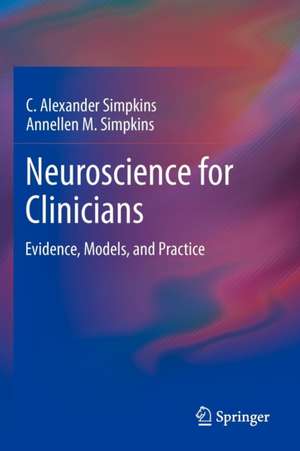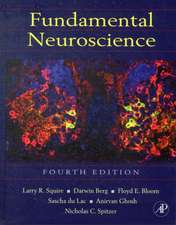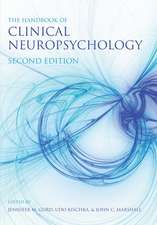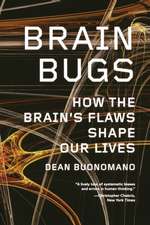Neuroscience for Clinicians: Evidence, Models, and Practice
Autor C. Alexander Simpkins, Annellen M. Simpkinsen Limba Engleză Paperback – 14 sep 2012
Preț: 532.34 lei
Preț vechi: 560.35 lei
-5% Nou
Puncte Express: 799
Preț estimativ în valută:
101.87€ • 105.25$ • 84.74£
101.87€ • 105.25$ • 84.74£
Carte tipărită la comandă
Livrare economică 19 martie-02 aprilie
Preluare comenzi: 021 569.72.76
Specificații
ISBN-13: 9781461448419
ISBN-10: 1461448417
Pagini: 368
Ilustrații: XIX, 345 p. 98 illus.
Dimensiuni: 155 x 235 x 19 mm
Greutate: 0.56 kg
Ediția:2013
Editura: Springer
Colecția Springer
Locul publicării:New York, NY, United States
ISBN-10: 1461448417
Pagini: 368
Ilustrații: XIX, 345 p. 98 illus.
Dimensiuni: 155 x 235 x 19 mm
Greutate: 0.56 kg
Ediția:2013
Editura: Springer
Colecția Springer
Locul publicării:New York, NY, United States
Public țintă
Professional/practitionerCuprins
The birth of a new science.-Unlocking the key to neuroscience terminology.- What is the Mind and Brain?.- Learning from brain damaged individuals.- Neuroimaging technologies.- Modeling the Brain.- Neurons and Neurotransmitters.- Brain structures.- Brain Pathways.- Neural Networks: How Neurons Think and Learn.- Evolution of the Brain over Ions of Time.- Brain Development through the Life Span.- Neuroplasticity and Neurogenesis: Changing Moment-by-Moment.- Principles for incorporating the Brain into Treatment.- Working with Attention.- Regulating Emotions.- Reconsolidating Memory.- Maximizing the Social Brain.- How Psychotherapy Changes the Brain.- Relieving Anxiety.- Finding a Better Balance for Depression and Bipolar Disorder.- Recovering from Addiction.
Recenzii
From the reviews:
“This book is a terrific introduction to basic neuroscience, as a prelude to understanding the current excitement surrounding the neural basis of mind – body interactions “
VS Ramachandran, Center for Brain and Cognition , UCSD
"Psychotherapist of all persuasions need to understand and apply principles of modern neuroscience. Drs Simpkins provide an eminently readable introduction to the practicalities that will advance treatment regardless of one's theoretical orientation. "Neuroscience for Clinicians" should be required reading."
Jeffrey K. Zeig, Ph.D.
The Milton Erickson Foundation
"A comprehensive overview of the field of neuroscience is a daunting task. The field is one in which divergent viewpoints are supported by emergent technology. State of the art discoveries are both enlightening and confusing, as each produces only a facet of understanding in a larger picture that has not been fully developed. Drs Alex and Annellen Simpkins straightforward easily understood language gives succinct explanations to describe the rationale and viewpoints that confound limits of clarity.
The narrative style is effective in capturing the readers’ attention for the way that science builds upon prior knowledge. A well-outlined eleven and half page table of contents, so detailed as to make the included index almost un-necessary, is followed by information that flows with intuitive logic. Beginning in ancient times, the development of neuroscience is traced by highlighting a long series of significant investigations and key discoveries. The progression from historical foundations to clinical applications and research frontiers is done in a style that the reader is able to follow with appreciation. Building on scientific discoveries, physiological, developmental information, the book explores the process of neuroplasticity and neurogenesis. Research and clinicalevidence are integrated throughout the book and support both the descriptive platform as well as the treatment approaches. Explanations are offered in logical sequence that facilitates a broader understanding of this complex topic while leading to clinical directions, the emphasis of the latter half of the book. While the potential for application is seemingly endless, the Simpkins have chosen to emphasize a few broad areas including: focus of attention, emotional regulation, anxiety as well as some specific areas including depression and addictions. Each topic addressed is explored utilizing models for application built upon the information base provided in the first half of the book.
The book is a resource that a professional may read for pleasure, keep as a reference, or use to stimulate his or her own thinking about possibilities for clinical approaches. Clinicians seeking to work with a specific problem are likely to find not only possible directions, but also solid rationale to support the directions. The generous inclusion of illustrations is of benefit in elucidating concepts.
While advancing technology has illuminated a great deal about the interplay of the brain and consciousness, much remains unknown; the dynamic inter-related elements of thought, behavior, and structure are elusive even to the most educated. Clinicians are continually seeking resources that will help us to understand what is known and provide rational solid foundations for what we will continue to learn. The Simpkins writing style combines textbook clarity while fostering interest. Neuroscience for Clinicians is an overview that provides a badly needed compass for navigation in territory that has become so dense with information that many clinicians have lost their bearings. The combination of explicit descriptions and acceptance for limits of what is not yet understood allows the reader to find direction as we continue to explore what the future willhold."
Roxanna Erickson Klein, RN, PhD
"Wow! Imagine two of the best therapists in the world writing a book where they lovingly and intentionally used implied meanings to assist you to feel better, recognize more of your competency, and encourage you to be an even better clinician and person, as you learn cutting-edge neuroscience! You will be very delighted with what you will now understand.
In this 345-page book, the Simpkins have created a classic that doesn’t just tell the history of neuroscience, help you to understand the brain, and how to use that knowledge for your work, but they have also given you a series of gifts. They have used their linguistic skills to evoke your creativity while indirectly supplying bits of clinical expertise based upon neuroscience in the volume proper, that you will be glad you know.
I love how the Simpkins made understandable some very complex material, and I especially enjoyed how their book inspired me to become a better person. On page 245, the information they offer was speaking on several levels. Relating a study about mirroring neurons with monkeys that seems to imply that monkeys understood intent, and how the Simpkins put it speaks to us on at least three levels. Recognizing the use of their craft and what they were saying, I felt inspired to become a better person.
The first part of the book set the stage for what was coming next, and, it was chock full of philosophy, biology, and the Simpkins’s unique blend of nurturing information. I found myself thinking of clients, friends, and colleagues that I wanted to tell about what I was learning, and I smiled at the implied messages the Simpkins left almost like a series of gifts, for you to find.
However, the middle part of the book got even better. Not only were they doing more of the same, they ramped it up, and made the information even more relevant, were more obvious about the positive implied meanings they were offering youthe reader. They began to also add in exercises that teach you experientially in overt ways, that you can easily repeat, as well as observations that you will find useful. The last third got even more intense for clinicians as they were offering so many practical observations, and information that will inspire your creativity as well as give you tools for working better with your clients. I made notes, marked up the book and in general became inspired, had eureka moments, and felt all warm and cared about being a therapist. The Simpkins were intentional about causing you the reader to have those types of experiences. Yours will be uniquely your own but you will have them when you read the book.
When the Simpkins offer practical exercises from meditation or ways to prescribe it for particular issues, they are speaking from another area of their expertise where they have authored several books. They do not call attention to their genuine wisdom and knowledge of meditation they simply state what they know.
In summary, you have a wonderful treat awaiting you that has gifts liberally offered so that you will have a positive emotional experience and learn important information about neuroscience. I am recommending it to every clinician I know, and quoting the information they give to clients, therapists and myself, over and over."
Reviewed by John Lentz, DMin
Shepherdsville, KY
“This work provides an introduction to the history, theories, and applications of neuroscience for practicing therapists and other psychological clinicians. The book is divided into six parts, with multiple chapters in each. The table of contents helpfully provides a breakdown of each chapter in one-to-two-page increments and serves as the primary organization for the book, while the index leads users to more specific concepts. … Useful for libraries supporting a clinical psychology or psychiatry program. Summing Up: Recommended. Graduate students,researchers/faculty, and professionals.” (R. Borchardt, Choice, Vol. 50 (9), May, 2013)
"C. Alexander Simpkins’ and Annellen M. Simpkins’ book Neuroscience for Clinicians is the book I have been waiting for. Milton Erickson admonished us to create unique models for each client. I found this a rather tall order. While Erickson gave perspectives and hypnotic techniques, he taught us to rely on our own observations and understandings to create specific interventions for each individual client. What I wanted was a book that helps us see our clients at multiple levels so we can create interventions from top-down and bottom-up. Neuroscience for Clinicians is such a book.
The book is divided into six parts with the first four parts laying the groundwork for the treatments. Parts one and two demystify the arcane world of neuroscience by reviewing it as a set of discoveries and explorations. The Simpkins make esoteric terms logical and easy to assimilate. It reads like a fascinating documentary. Standing on the shoulders of the first two parts, part three gives a clean overview of our current knowledge of how nerves work, individually and as networks. Part four introduces us to neuroplasticity and its relationship to change.
Part five moves us into creating clinical applications. It shows us how understanding brain processes allows us to develop effective treatments. I especially like the six key principles provided in Chapter 14.
Part six brings it all together. Here, the Simpkins show us how psychotherapy can change the brain, in the most frequently diagnoses disorders. This section includes examples of suggested exercises for therapeutically altering brain function in depression, anxiety, addictions, and bipolar disorders.
It is an amazingly easy read for a book on the applications of the neurosciences. The six parts are logical progressions that lead from understanding to intervention. Each chapter within eachpart is a natural extension of the previous chapter. Within each chapter, each step interconnects with the one that came before. The book flows effortlessly from one logical level to the next. It is artistry.
I recommend this book for those of us who identify ourselves as Scientific Humanists. (How is that for an apparent oxymoron?) We want to know why as well as how. It provides answers for both the beginning and experienced clinician given that it satisfies each need that the two levels seek.
In Neuroscience for Clinicians, the beginning therapist can use its easy-to-learn overview of general brain functioning to gain confidence and meaning in the impact of his or her professional interventions. It allows the therapist to develop a greater understanding of the deeper function of therapeutic technique. For the more experienced therapist, Neuroscience for Clinicians provides a review of pertinent elements we can use to incorporate in our perspectives and create new techniques. I especially like how it provides handy pegs for me to hang my ideas on. And, on those days when my intuition is a bit sluggish, it provides a framework for me to systematically build my models.
Among all the books on my shelves, Neuroscience for Clinicians is an exceptional book, and I highly recommend it."
Richard E. Landis, Ph.D.
The Milton H. Erickson Foundation Newsletter, Vol. 33, No. 1
Spring 2013
“This book is a terrific introduction to basic neuroscience, as a prelude to understanding the current excitement surrounding the neural basis of mind – body interactions “
VS Ramachandran, Center for Brain and Cognition , UCSD
"Psychotherapist of all persuasions need to understand and apply principles of modern neuroscience. Drs Simpkins provide an eminently readable introduction to the practicalities that will advance treatment regardless of one's theoretical orientation. "Neuroscience for Clinicians" should be required reading."
Jeffrey K. Zeig, Ph.D.
The Milton Erickson Foundation
"A comprehensive overview of the field of neuroscience is a daunting task. The field is one in which divergent viewpoints are supported by emergent technology. State of the art discoveries are both enlightening and confusing, as each produces only a facet of understanding in a larger picture that has not been fully developed. Drs Alex and Annellen Simpkins straightforward easily understood language gives succinct explanations to describe the rationale and viewpoints that confound limits of clarity.
The narrative style is effective in capturing the readers’ attention for the way that science builds upon prior knowledge. A well-outlined eleven and half page table of contents, so detailed as to make the included index almost un-necessary, is followed by information that flows with intuitive logic. Beginning in ancient times, the development of neuroscience is traced by highlighting a long series of significant investigations and key discoveries. The progression from historical foundations to clinical applications and research frontiers is done in a style that the reader is able to follow with appreciation. Building on scientific discoveries, physiological, developmental information, the book explores the process of neuroplasticity and neurogenesis. Research and clinicalevidence are integrated throughout the book and support both the descriptive platform as well as the treatment approaches. Explanations are offered in logical sequence that facilitates a broader understanding of this complex topic while leading to clinical directions, the emphasis of the latter half of the book. While the potential for application is seemingly endless, the Simpkins have chosen to emphasize a few broad areas including: focus of attention, emotional regulation, anxiety as well as some specific areas including depression and addictions. Each topic addressed is explored utilizing models for application built upon the information base provided in the first half of the book.
The book is a resource that a professional may read for pleasure, keep as a reference, or use to stimulate his or her own thinking about possibilities for clinical approaches. Clinicians seeking to work with a specific problem are likely to find not only possible directions, but also solid rationale to support the directions. The generous inclusion of illustrations is of benefit in elucidating concepts.
While advancing technology has illuminated a great deal about the interplay of the brain and consciousness, much remains unknown; the dynamic inter-related elements of thought, behavior, and structure are elusive even to the most educated. Clinicians are continually seeking resources that will help us to understand what is known and provide rational solid foundations for what we will continue to learn. The Simpkins writing style combines textbook clarity while fostering interest. Neuroscience for Clinicians is an overview that provides a badly needed compass for navigation in territory that has become so dense with information that many clinicians have lost their bearings. The combination of explicit descriptions and acceptance for limits of what is not yet understood allows the reader to find direction as we continue to explore what the future willhold."
Roxanna Erickson Klein, RN, PhD
"Wow! Imagine two of the best therapists in the world writing a book where they lovingly and intentionally used implied meanings to assist you to feel better, recognize more of your competency, and encourage you to be an even better clinician and person, as you learn cutting-edge neuroscience! You will be very delighted with what you will now understand.
In this 345-page book, the Simpkins have created a classic that doesn’t just tell the history of neuroscience, help you to understand the brain, and how to use that knowledge for your work, but they have also given you a series of gifts. They have used their linguistic skills to evoke your creativity while indirectly supplying bits of clinical expertise based upon neuroscience in the volume proper, that you will be glad you know.
I love how the Simpkins made understandable some very complex material, and I especially enjoyed how their book inspired me to become a better person. On page 245, the information they offer was speaking on several levels. Relating a study about mirroring neurons with monkeys that seems to imply that monkeys understood intent, and how the Simpkins put it speaks to us on at least three levels. Recognizing the use of their craft and what they were saying, I felt inspired to become a better person.
The first part of the book set the stage for what was coming next, and, it was chock full of philosophy, biology, and the Simpkins’s unique blend of nurturing information. I found myself thinking of clients, friends, and colleagues that I wanted to tell about what I was learning, and I smiled at the implied messages the Simpkins left almost like a series of gifts, for you to find.
However, the middle part of the book got even better. Not only were they doing more of the same, they ramped it up, and made the information even more relevant, were more obvious about the positive implied meanings they were offering youthe reader. They began to also add in exercises that teach you experientially in overt ways, that you can easily repeat, as well as observations that you will find useful. The last third got even more intense for clinicians as they were offering so many practical observations, and information that will inspire your creativity as well as give you tools for working better with your clients. I made notes, marked up the book and in general became inspired, had eureka moments, and felt all warm and cared about being a therapist. The Simpkins were intentional about causing you the reader to have those types of experiences. Yours will be uniquely your own but you will have them when you read the book.
When the Simpkins offer practical exercises from meditation or ways to prescribe it for particular issues, they are speaking from another area of their expertise where they have authored several books. They do not call attention to their genuine wisdom and knowledge of meditation they simply state what they know.
In summary, you have a wonderful treat awaiting you that has gifts liberally offered so that you will have a positive emotional experience and learn important information about neuroscience. I am recommending it to every clinician I know, and quoting the information they give to clients, therapists and myself, over and over."
Reviewed by John Lentz, DMin
Shepherdsville, KY
“This work provides an introduction to the history, theories, and applications of neuroscience for practicing therapists and other psychological clinicians. The book is divided into six parts, with multiple chapters in each. The table of contents helpfully provides a breakdown of each chapter in one-to-two-page increments and serves as the primary organization for the book, while the index leads users to more specific concepts. … Useful for libraries supporting a clinical psychology or psychiatry program. Summing Up: Recommended. Graduate students,researchers/faculty, and professionals.” (R. Borchardt, Choice, Vol. 50 (9), May, 2013)
"C. Alexander Simpkins’ and Annellen M. Simpkins’ book Neuroscience for Clinicians is the book I have been waiting for. Milton Erickson admonished us to create unique models for each client. I found this a rather tall order. While Erickson gave perspectives and hypnotic techniques, he taught us to rely on our own observations and understandings to create specific interventions for each individual client. What I wanted was a book that helps us see our clients at multiple levels so we can create interventions from top-down and bottom-up. Neuroscience for Clinicians is such a book.
The book is divided into six parts with the first four parts laying the groundwork for the treatments. Parts one and two demystify the arcane world of neuroscience by reviewing it as a set of discoveries and explorations. The Simpkins make esoteric terms logical and easy to assimilate. It reads like a fascinating documentary. Standing on the shoulders of the first two parts, part three gives a clean overview of our current knowledge of how nerves work, individually and as networks. Part four introduces us to neuroplasticity and its relationship to change.
Part five moves us into creating clinical applications. It shows us how understanding brain processes allows us to develop effective treatments. I especially like the six key principles provided in Chapter 14.
Part six brings it all together. Here, the Simpkins show us how psychotherapy can change the brain, in the most frequently diagnoses disorders. This section includes examples of suggested exercises for therapeutically altering brain function in depression, anxiety, addictions, and bipolar disorders.
It is an amazingly easy read for a book on the applications of the neurosciences. The six parts are logical progressions that lead from understanding to intervention. Each chapter within eachpart is a natural extension of the previous chapter. Within each chapter, each step interconnects with the one that came before. The book flows effortlessly from one logical level to the next. It is artistry.
I recommend this book for those of us who identify ourselves as Scientific Humanists. (How is that for an apparent oxymoron?) We want to know why as well as how. It provides answers for both the beginning and experienced clinician given that it satisfies each need that the two levels seek.
In Neuroscience for Clinicians, the beginning therapist can use its easy-to-learn overview of general brain functioning to gain confidence and meaning in the impact of his or her professional interventions. It allows the therapist to develop a greater understanding of the deeper function of therapeutic technique. For the more experienced therapist, Neuroscience for Clinicians provides a review of pertinent elements we can use to incorporate in our perspectives and create new techniques. I especially like how it provides handy pegs for me to hang my ideas on. And, on those days when my intuition is a bit sluggish, it provides a framework for me to systematically build my models.
Among all the books on my shelves, Neuroscience for Clinicians is an exceptional book, and I highly recommend it."
Richard E. Landis, Ph.D.
The Milton H. Erickson Foundation Newsletter, Vol. 33, No. 1
Spring 2013
Notă biografică
C. Alexander Simpkins, PHD and Annellen M. Simpkins, PHD are psychologists specializing in neuroscience, psychotherapy, meditation, and hypnosis. The Simpkins have specialized in the unconscious in their research, clinical work, and workshops. They are authors of 26 books, many of them bestsellers. Their most recent books on neuroscience are The Dao of Neuroscience (Norton, 2010), and Neuro-Hypnosis (Norton, 2010). They have also written about meditation for healthy mind-brain change: The Tao of Bipolar Disorder (forthcoming from New Harbinger, 2013), Zen Meditation in Psychotherapy (Wiley, 2012), Meditation and Yoga in Psychotherapy: Techniques for Clinical Practice (Wiley, 2011), and Meditation for Therapists and Their Clients (Norton 2009). Their books have over 20 foreign editions and have won numerous awards. Drs. Simpkins have been practicing psychotherapy for more than three decades, and have taught their meditative and hypnotic methods to facilitate mind-brain change to people of all ages. They have been involved in neuroscience for 15 years and have been integrating it into treatments and helping to bring the most recent research findings to practitioners. They present seminars at professional conferences, state mental hospitals, university campuses, and to popular and professional audiences around the world. They have performed psychotherapy research and are currently doing a neuroscience study of unconscious movement. They studied with psychotherapy masters, including Milton H. Erickson, Jerome D. Frank, Carl Rogers, Lawrence Kubie, and Ernest Rossi, and neuroscience innovators including Vilayanur Ramachandran, Jaime Pineda, Paul and Patricia Churchland, Stephen Anagnostaras, and William Bechtel. Their Eastern philosophy influence along with their commitment to continual learning and therapeutic effectiveness has helped them to see therapy through the crystal of a unique vision, which they bring to you with warmth and clarity in their books and seminars.
Textul de pe ultima copertă
Neuroscience for Clinicians: Evidence, Models, and Practice
C. Alexander Simpkins and Annellen M. Simpkins
Psychology began as the study of thoughts, moods, and emotions—the realm of the mind—gradually adding findings from neuroscience about the workings of the brain. Current interest in mind-body health and in the biological underpinnings of mental illness is creating new opportunities for therapists to bring brain and mind together in the treatment room.
Neuroscience for Clinicians introduces an elegant new lens not only for understanding the role of the brain in pathology, but also for using this knowledge in therapy, to help the mind by treating the brain. Offering conceptual models and empirical data as well as hands-on techniques and practical guidelines, it describes methods versatile enough to be used by therapists across theoretical orientations. Detailed discussion of neuroplasticity explores the brain’s capacity for change and in-depth case studies of anxiety, substance abuse, cognitive problems, and mood disorders demonstrate the mind’s ability to alter brain structures during the course of therapy. And the book is written at a comfort level that requires no previous neuroscience background. Featured in the coverage:
C. Alexander Simpkins and Annellen M. Simpkins
Psychology began as the study of thoughts, moods, and emotions—the realm of the mind—gradually adding findings from neuroscience about the workings of the brain. Current interest in mind-body health and in the biological underpinnings of mental illness is creating new opportunities for therapists to bring brain and mind together in the treatment room.
Neuroscience for Clinicians introduces an elegant new lens not only for understanding the role of the brain in pathology, but also for using this knowledge in therapy, to help the mind by treating the brain. Offering conceptual models and empirical data as well as hands-on techniques and practical guidelines, it describes methods versatile enough to be used by therapists across theoretical orientations. Detailed discussion of neuroplasticity explores the brain’s capacity for change and in-depth case studies of anxiety, substance abuse, cognitive problems, and mood disorders demonstrate the mind’s ability to alter brain structures during the course of therapy. And the book is written at a comfort level that requires no previous neuroscience background. Featured in the coverage:
- Learning from brain-damaged individuals.
- How neurons think and learn.
- Neuroplasticity and neurogenesis: moment-by-moment change.
- Incorporating the brain into treatment.
- Maximizing the social brain.
- Shifting the nervous system in common disorders. Clinicians interested in understanding the brain’s interactions with the mind and its role in psychological problems will find Neuroscience for Clinicians stimulating and adaptable to their own approaches to therapy. The book can also enhance neuroscience and biological psychology classes in cognitive science, medical, and psychology departments.
Caracteristici
Very clear introduction to neuroscience for practicing psychologists Helpful definitions of neuroterminiology throughout the book A broad range of topics are covered, based in the latest research findings, that are studied as part of this field including brain development, neural networks, modeling methods, technologies, brain elements, systems, and functions Explicates theory of embodied cognition Includes supplementary material: sn.pub/extras














